Two years ago I wrote a blog post titled “This Home Inspector’s Love Affair With Flashlights“, wherein I gushed about my new Fenix TK35 flashlight. Over the past two years I’ve tried a number of other flashlights, and I’m happy to say that the Fenix TK35 is still my go-to flashlight, but if my dream flashlight ever gets made, I’ll kick the TK35 to the curb. I’ll come back to that. Today, I’ll give my two cents on a few other LED flashlights that I’ve tried. The flashlights below all use the same 18650 lithium ion batteries.
By the way, this is a home inspectors perspective; if you’re looking for technical flashlight reviews, check out CandlePowerForums.
Armytek Barracuda XM-L2 (Warm)
This is an extremely impressive looking flashlight that feels great in your hand and could easily double as a club. With a stated max light output of 1240 lumens, it’s the brightest of all the flashlights mentioned here. It also had a very warm light output, which means the light looked yellow-ish, not white or blue. The flashlight comes in a padded case along with batteries, a belt holster, two 18650 batteries, an AC battery charger, and a DC battery charger. Not all of that stuff is listed on the web site, so I’m not sure why they were included.
My problem with this flashlight is that it’s unwieldy. To carry this flashlight around, I had to use the holster. Once the flashlight is in the holster it’s secure and won’t fall out, but it’s not easy to put the flashlight into the holster or take it out. This is also a flashlight that requires two-handed operation; it takes two hands to get the flashlight out of the holster, and then takes two hands to turn it on, because the on/off switch is located on the bottom of the flashlight.
As a home inspector, I probably take my flashlight out of my pouch, turn it on, turn it off, then put it back into my pouch about 50 – 100 times during each inspection. With the amount of time and effort it takes to get this flashlight out of it’s holster and turn it on, the flashlight is unusable. It’s marketed as a “Search and Rescue” flashlight; maybe it would do a great job at that, but I wouldn’t know.
Fenix TK35
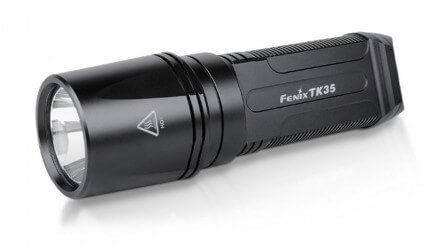 This flashlight is my workhorse. I’ve been using this flashlight for over two years now, and it has served me well. It has a stated max output of 820 to 900 lumens, it feels great in your hand, and has separate buttons for on/off and brightness.
This flashlight is my workhorse. I’ve been using this flashlight for over two years now, and it has served me well. It has a stated max output of 820 to 900 lumens, it feels great in your hand, and has separate buttons for on/off and brightness.
I keep this flashlight in my tool pouch, so it’s easy to grab and put away with one hand. Because of it’s compact shape, operating this flashlight with one hand feels natural. You can’t go wrong with this flashlight.
Fenix also has great warranty service; I wore out the rubber button at the bottom of the flashlight this fall and had to send the flashlight in for repair. Instead of replacing the piece of rubber, they just sent me a brand new flashlight. It seemed a bit excessive, but I sure didn’t complain.
Update: this flashlight has been discontinued. The next closest thing is the TK35UE. But there’s another version available for just a little more, which is the TK35R.
TK35 Knock-Off
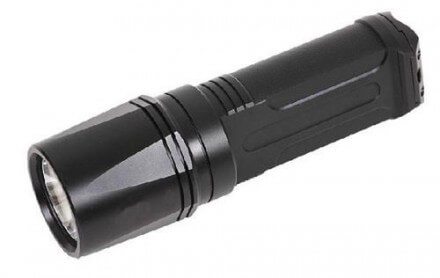 If you search Ebay for TK35, you can find a TK35 knock-off flashlight selling for under $50, which includes batteries and a charger. I ordered one of these to use as a backup flashlight while my TK35 was out for repair, and found that I pretty much got what I paid for.
If you search Ebay for TK35, you can find a TK35 knock-off flashlight selling for under $50, which includes batteries and a charger. I ordered one of these to use as a backup flashlight while my TK35 was out for repair, and found that I pretty much got what I paid for.
- While the light output on the TK35 is white, the light output on the knockoff is blue.
- The TK35 remembers the last brightness setting, but the knockoff resets every time the flashlight is turned off. This is extremely annoying.
- The buttons on the knockoff are recessed just a little more than the buttons on the TK35, making them more difficult to operate with one hand. It’s much more annoying than you might think.
- The light seems to flicker, much like a fluorescent light flickers when you see it out of the corner of your eye. Maybe that has something to do with the cool spectrum of light?
A couple of other guys in my company bought this knockoff flashlight before I did, and I’m pretty sure none of their flashlights are working anymore. Of course, this light doesn’t come with any kind of warranty. Don’t buy this POS.
UltraFire C8
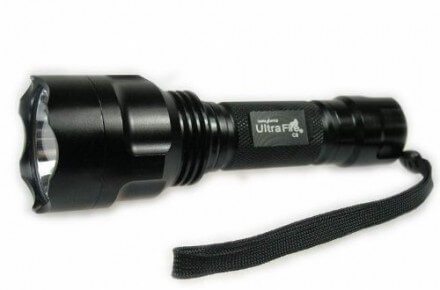 I recommend this flashlight as an inexpensive backup to anyone who already has the 18650 batteries and charger. This flashlight can be purchased on Amazon for $14, and the light output is very similar to that of the TK35. It has a stated output of 1000 lumens.
I recommend this flashlight as an inexpensive backup to anyone who already has the 18650 batteries and charger. This flashlight can be purchased on Amazon for $14, and the light output is very similar to that of the TK35. It has a stated output of 1000 lumens.
My main complaint with this flashlight is that it’s difficult to toggle brightness modes; you need to give the on/off button a half push to cycle through modes, and it takes a while to get the feel of what a half-click is. Also, if the batteries don’t have a full charge this flashlight refuses to stay on the brightest setting.
Fenix TK22
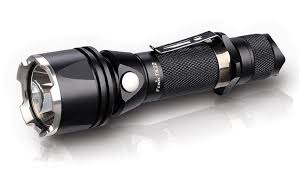
This isn’t a bad flashlight, but as far as I can tell the main thing that differentiates this flashlight is that it’s waterproof. For a home inspector, that’s not a selling feature. With a $95 price tag on Amazon and a max light output of 650 lumens, I see no reason to purchase this flashlight.
Update: the new version is the TK22R.
Fenix PD35
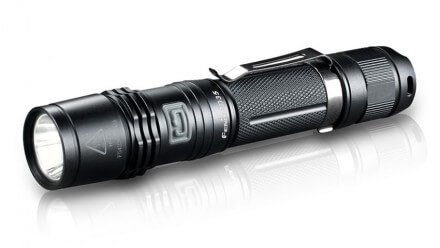 This flashlight is cute as a button, looking like an oversized pen light. If you need to carry a club around, forget this flashlight. The surprising thing about this flashlight is the brightness; it has an impressive 850 lumen output. In a head-to-head comparison, I couldn’t tell which flashlight was brighter; my TK35 or this one. If I had to buy a new flashlight, I’d get this one and I’d probably start using it in place of my TK35. Amazon sells this flashlight for $75.
This flashlight is cute as a button, looking like an oversized pen light. If you need to carry a club around, forget this flashlight. The surprising thing about this flashlight is the brightness; it has an impressive 850 lumen output. In a head-to-head comparison, I couldn’t tell which flashlight was brighter; my TK35 or this one. If I had to buy a new flashlight, I’d get this one and I’d probably start using it in place of my TK35. Amazon sells this flashlight for $75.
With a flashlight this small, I can even use my retractable tool tether.
Update: new version is the PD35R.
The flashlights discussed above are shown below for size comparison. Click the image for a high-res version.
My Dream Flashlight
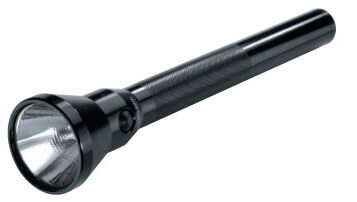 The first flashlight I used as a home inspector was an Ultra Stinger, and I still miss the design. The shaft was long and skinny, so I marked it at one-inch increments to use it as a ruler. I would frequently include it in home inspection photos showing things like balusters spaced too far apart at guardrails, or auto-reverse sensors installed too high at garage door openers. Because the shaft was skinny and didn’t have a flared base, it was nice to use my flashlight to measure insulation in attics as well.
The first flashlight I used as a home inspector was an Ultra Stinger, and I still miss the design. The shaft was long and skinny, so I marked it at one-inch increments to use it as a ruler. I would frequently include it in home inspection photos showing things like balusters spaced too far apart at guardrails, or auto-reverse sensors installed too high at garage door openers. Because the shaft was skinny and didn’t have a flared base, it was nice to use my flashlight to measure insulation in attics as well.
 I used a belt loop holster to keep the flashlight on my left hip, and I could easily pull the flashlight out and put it back with either hand. When walking around in attics, I could turn the light on and leave it attached to my hip when I needed to climb around with two hands, which was great.
I used a belt loop holster to keep the flashlight on my left hip, and I could easily pull the flashlight out and put it back with either hand. When walking around in attics, I could turn the light on and leave it attached to my hip when I needed to climb around with two hands, which was great.
Finally, this flashlight had very easy one-handed operation, because the switch was ergonomically located near the head of the flashlight.
I would still use this flashlight today if not for the miserable battery life and sub-par light output. The bulbs used to burn out constantly, so I installed an aftermarket TerraLux LED light bulb, which increased the light output and battery life, but it was too little too late. The Ni-Cad batteries just don’t compare to lithium-ion.
The perfect flashlight for a home inspector would be something the same size and shape as the Stinger Ultra, would have a powerful LED light bulb with a wide spill and minimal spot focus, would take two 18650 lithium-ion batteries, and would come with some kind of high-visibility etching in the shaft showing 1″ measurements.
I still have my belt holster. I’m keeping my fingers crossed.
Author: Reuben Saltzman, Structure Tech Home Inspections

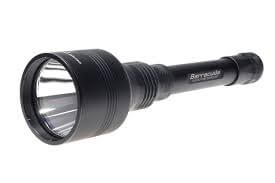
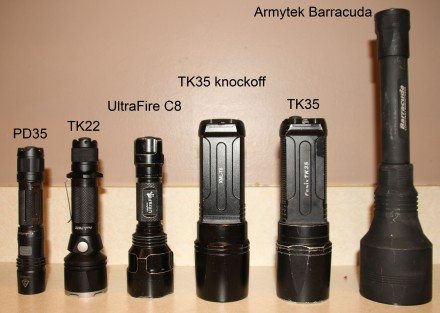
Bruce Mcgoose
January 21, 2014, 1:03 pm
I am interested to see what type of tool pouch you use. My TK35 is kept in the factory holster, which is quite cumbersome.
I have been thinking about getting the “Get to Work Vest” from occidental leather, they make some top-notch stuff.
Reuben Saltzman
January 21, 2014, 4:29 pm
The last time I replaced my tool pouch I tried a ton of different pouches. This was the only one I could live with: http://www.amazon.com/gp/product/B000COYRYY/ref=oh_details_o05_s00_i00?ie=UTF8&psc=1 . I put my flashlight in the largest pouch opening.
Michael
January 21, 2014, 10:42 pm
The flicker from the knockoff flashlight was probably due to sub-par dimming electronics. To dim, lots of LED things will just turn on and off really fast. But if they do that too slowly, the eye can see a series of dots as it moves side to side, like — — — –. Some cars with LED brake lights will do this when you see them at night and they are in tail light (dimmed) mode. LED Christmas lights too (but not due to dimming, just from running off of 60Hz AC).
Reuben Saltzman
January 22, 2014, 6:10 am
@Michael – that makes sense. Thanks for the explanation.
Reuben (not the inspector)
January 22, 2014, 9:58 pm
How about headlamps? Ever use a headlamp? Hands-free!
Reuben Saltzman
January 23, 2014, 5:05 am
@ReubenNTI – I have a halfway decent LED headlamp, but it just doesn’t compare to any of the high-power flashlights. I’ve seen newer high-power headlamps out there… maybe I ought to try one. ArmyTek makes one that looks pretty bad-ass: http://www.armytek.com/products/flashlights/headlamps/armytek-wizard-xm-l2.html